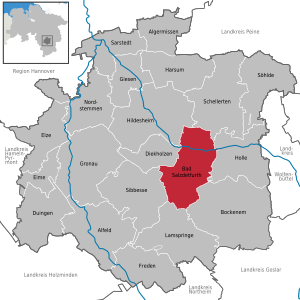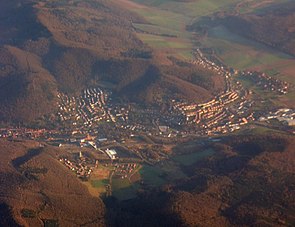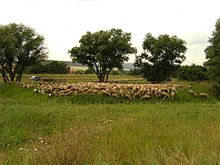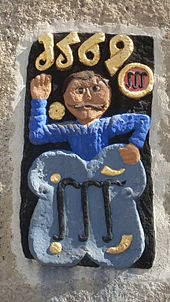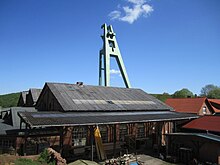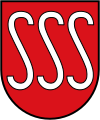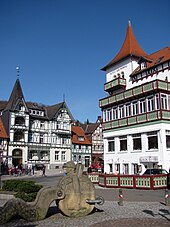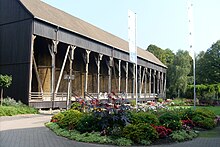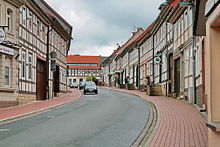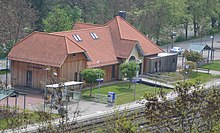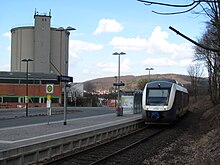Bad Salzdetfurth
| coat of arms | Germany map | |
|---|---|---|

|
Coordinates: 52 ° 4 ′ N , 10 ° 1 ′ E |
|
| Basic data | ||
| State : | Lower Saxony | |
| County : | Hildesheim | |
| Height : | 118 m above sea level NHN | |
| Area : | 67.11 km 2 | |
| Residents: | 13,139 (Dec. 31, 2019) | |
| Population density : | 196 inhabitants per km 2 | |
| Postal code : | 31162 | |
| Primaries : | 05063, 05060, 05064 | |
| License plate : | HI, ALF | |
| Community key : | 03 2 54 005 | |
| LOCODE : | DE BSF | |
City administration address : |
Oberstrasse 6 31162 Bad Salzdetfurth |
|
| Website : | ||
| Mayor : | Björn Gryschka ( independent ) | |
| Location of the city of Bad Salzdetfurth in the Hildesheim district | ||
Bad Salzdetfurth is a small town with around 13,500 inhabitants in the Hildesheim district in southern Lower Saxony . The city is a regionally important recreational, health resort, clinic and industrial location. It is officially recognized as a saltwater and mud spa .
Bad Salzdetfurth's history is closely linked to the extraction of rock and potash . The first written mention of the city can be traced back to the year 1194. The first inhabitants of the city were in all probability salt boilers. The Kaliwerke Salzdetfurth AG , the oldest predecessor company of today's K + S Aktiengesellschaft , had from 1889 to 1971 their headquarters in Bad Salzdetfurth. Potash mining, which is important for the local economy, was discontinued in 1992. The population has been falling since 2001.
The urban area in its current boundaries was created in 1974 through the merger with twelve surrounding communities.
Bad Salzdetfurth is about eleven kilometers south of Hildesheim . The closest major cities are Salzgitter (about 24 km northeast), Hanover (39 km north) and Braunschweig (about 42 km northeast).
geography
location
Bad Salzdetfurth is located in the Innerstebergland , a sub-area of the natural region of Lower Saxony Bergland . The urban area is characterized by a multitude of landscape forms, it mainly consists of agricultural and forest areas, while about one sixth of the urban area is settlement and traffic area. The city borders in the north on the fertile and intensively arable loess soils of the Hildesheimer Börde , to the south-east, not far, lies the Harz .
The urban area is about 67 square kilometers. The maximum north-south extension is about twelve kilometers, the maximum east-west extension eight kilometers.
The inner city flows through the urban area in the north between the villages of Hockeln, Listringen, Heinde, Klein Düngen and Groß Düngen as well as Gut Walshausen in a westerly direction .
The main town Bad Salzdetfurth is embedded in the mixed beech forests of the Hildesheim Forest in the west and the Sauberge in the east. The Lamme flows through the town in a northerly direction and flows into the innermost part of Groß Düngen .
The highest mountain in Bad Salzdetfurth is the Bösenberg in the Salzdetfurth Forest at 339 meters above sea level . The wooded Sothenberg in the east of the city is around 235 meters high. The so-called Hexentreppe with 86 steps and a footpath connect it to the town center.
Community structure
The city of Bad Salzdetfurth consists of the following 13 districts:
| District | Residents |
|---|---|
| Bad Salzdetfurth | 4913 |
| Bodenburg | 1823 |
| Breinum | 643 |
| Detfurth | 426 |
| Large fertilizing | 1158 |
| Heinde | 1285 |
| Crouch | 179 |
| Small fertilizing | 391 |
| Lechstedt | 680 |
| Listringen | 172 |
| Estrum | 377 |
| Wehrstedt | 1053 |
| Wesseln | 854 |
Neighboring communities
Bad Salzdetfurth borders clockwise, starting in the northeast, on the community Schellerten , the community Holle , the city Bockenem , the integrated community Lamspringe , the integrated community Sibbesse , the community Diekholzen and the district town Hildesheim .
climate
Bad Salzdetfurth is located in the moderate climate zone in the transition area from the maritime climate to the more continental climate. The warmest month is July with an average of 17 ° C, the coldest month is January with an average of 0 ° C. The annual average temperature is 8.6 ° C. Over the course of a year, an average of 700 mm of precipitation falls. These are spread over the whole year.
history
First settlement, city foundation and Middle Ages
It is likely that the first people lived in the area of today's Bad Salzdetfurth during the warm periods of the last cold period . The land north and south of the Lamme Gorge is seen as the original cell of the city. North of the Lamme Gorge, an old trade route crossed the river in a north-south direction in a ford . A small rural settlement with the name Detfurth (also: Detvorde, Thietforde or Detforde, from "Det" or "Thiet", the people or the people) arose here even before Christianization . The favorable traffic situation ensured that a first church was built here in the 9th century, which received the rank of archdeaconate church . South of the Lamme Gorge, the beginnings of the districts of Bodenburg and Wehrstedt go back to the 9th and 10th centuries.
It is not known when and by whom Bad Salzdetfurth was founded. Local legend reports that a Knight von Steinberg got lost in his vast forest areas while hunting a stag. Plagued by thirst, he drank from a spring that he found at the foot of the lamb. Instead of fresh fresh water, however, salty water (brine) gushed out. After a moment's discomfort, the knight realized the wealth that this discovery could bring to him. At the time, table salt was a sought-after and valuable commodity. The knight had salt boilers come, who cleared the forest and built boiling pans with salt pans.
The resulting village was initially viewed as part of the existing Detfurth village and referred to as "dat Solt to Detforde". The only historical evidence of this legend is that the von Steinberg family had rich estates in the Hildesheimer Land.
Bad Salzdetfurth was first mentioned in a document by Bishop Hartbert von Hildesheim , who testified in 1214 that Konrad von Steinberg sold four pans to the Lamspringe Benedictine monastery in 1194, along with the forest belonging to it, at the already existing village of “Thietforde” for 25 marks.
The first inhabitants of Bad Salzdetfurth were probably salt boilers. These extracted the salt in specially built salt boiling huts or pans by heating the brine. The abundant wood in the area was used as fuel. The salt boilers were initially serfs of the Lords of Steinberg and only gained more freedom towards the end of the 14th century. In 1360 they founded the “Salt Pans Guild” , which still exists today , whose members were able to call almost all the salt pans their own by 1400.
Bad Salzdetfurth developed into a locally important trading and transshipment center. The location on the old Frankfurter Heerstraße, an important trade route that connected northern and southern Germany and today roughly corresponds to the course of Bundesstraße 243 , had a beneficial effect . The salt carriers and carters brought their goods and a. to Hanover, Göttingen and Braunschweig.
Early modern age
The 17th century was overshadowed mainly by the two major fire disasters in 1605 and 1695, which destroyed almost all houses in the local area. Much of today's old town and St. George's Church were built as part of the subsequent reconstruction.
Since the existing fuel was no longer sufficient due to the constant increase in salt production, it was decided in 1746 to build the first graduation tower .
In 1794, Bad Salzdetfurth was hit again by a major fire that destroyed a large part of the rear buildings in Oberstraße.
In 1814 Bad Salzdetfurth was also hit by a destructive flood.
19th century
After the end of the Napoleonic Wars , salt sales began to stagnate. The decisive factor here were initially trade barriers resulting from tax and customs disputes between the Kingdom of Hanover and the newly founded Duchy of Braunschweig .
After the Kingdom of Hanover was annexed by Prussia in 1866 , sales of Bad Salzdetfurth salt plummeted. Bad Salzdetfurth's rather unfavorable transport connections, the rising wood prices, the levied salt tax and the temporarily neglected investments led to a lack of competitiveness, especially compared to the salt works in Lüneburg and Staßfurt . At the same time, as a result of the development of mining salt production and the abolition of the Prussian salt monopoly in 1868, the supply available on the market increased.
With the construction of the first brine bathhouse, the city tried to develop alternative sources of income. On May 28, 1857, the birthday of the then King of Hanover Georg V , the spa business was opened in Bad Salzdetfurth. The number of spa guests grew steadily in the following decades. In the 1880s, around 3,000 spa guests were received annually. Since the guest accommodation in private houses was no longer sufficient, a lodging house, the Gildehaus, was built in 1888.
Industrial potash mining reached Bad Salzdetfurth in the last decade of the 19th century. In 1891 the first "salt extraction contract" was signed between the Goslar corporation for mining and deep drilling and the landowners in Bad Salzdetfurth. In return for compensation, this allowed the mining of the land. In 1893 the first potash deposit was discovered while drilling below the “Welfenhöhe” at a depth of about 630 meters and in 1896 the first sinking work finally started. In 1900, the headquarters of the stock corporation for mining and deep drilling in Goslar was relocated to Bad Salzdetfurth and the company was renamed "Kaliwerke Salzdetfurth AG" . Potash mining grew steadily. In 1907 a second shaft was sunk a little further south of the existing shaft, and a third in 1914.
The rapid growth of the potash industry brought Bad Salzdetfurth high tax revenues and a considerable expansion of the infrastructure. At the beginning of the First World War, the potash plant had long since risen to become the largest employer in the area. It employed about 650 people.
During the First World War , around 300 of the 2300 inhabitants were called up for military service. At the end of the war Bad Salzdetfurth had 94 dead and missing to mourn. It can also be assumed that numerous civilians - especially in the turnip winter of 1916/17 - died as a result of malnutrition.
Weimar Republic and National Socialism
By decree of the Prussian State Ministry, Bad Salzdetfurth was given the additional designation "Bad" on December 10, 1921. The economic situation of Bad Salzdetfurth in the 1920s can be described as tense.
In the early 1930s, the NSDAP was also very popular in Bad Salzdetfurth. In the Reichstag elections in 1933, the NSDAP received around 29 percent of the approximately 19,000 votes cast in the Hildesheim district. After the seizure of power by the National Socialists brisk construction activities, where among other things the (now demolished) began in Bad Salzdetfurth Hostel and the swimming pool were built.
During the Second World War, life in Bad Salzdetfurth initially (apparently) went its usual course. Overall, the food situation was adequate. During the air raid on Hildesheim on March 22, 1945, individual bombs also hit the city of Bad Salzdetfurth and destroyed two houses in Göttingstrasse, among other places. Shortly before the end of the war, a bunker was built under the Kreuzberg stairs. The Second World War ended in Bad Salzdetfurth with the peaceful invasion of American soldiers on April 8, 1945.
Since the Second World War
The years after the Second World War were marked by heavy immigration from the former eastern regions. There was a great housing shortage. This could only be reduced by new construction activity that began around 1948, which was financially supported in particular by the potash plant. The influx of expellees led to tensions in the social life of the city in Bad Salzdetfurth - despite the economic situation recovering rapidly from 1948 onwards.
The potash plant itself had already resumed operations in autumn 1945 and in 1948 already employed around 1,100 people. In 1948 the Bad Salzdetfurth saltworks was shut down.
The municipality of Bad Salzdetfurth was declared a city on December 1, 1949. In 1968 it was officially recognized as a spa.
Since the 1950s, there has been a significant increase in productivity in potash mining, which has led to a gradual reduction in jobs.
On March 1, 1974, the municipalities of Bodenburg (Flecken), Breinum, Detfurth, Groß Düngen, Heinde, Hockeln, Klein Düngen, Lechstedt, Listringen, Östrum, Wehrstedt and Wesseln were incorporated as a result of the regional reform .
For economic reasons, the Bad Salzdetfurth potash plant - although its supplies would have lasted for many decades - was shut down in 1992 and salt mining in Bad Salzdetfurth ended. The history of the city of Bad Salzdetfurth has since been shaped by structural change .
Place name
Earlier place names of Salzdetfurth were Thietforde in the 12th century and Detvforde in 1207, Thietforde in 1214, Ditforde in 1305 and Detforde in 1458. The place developed on a saltworks south of Detfurth and bears its name. The term used today shows the high German word “salt”, traditionally Low German “solt” and Latin “salinae” for “salt works, salt storage, saline”. The older name Detfurth is a compound whose basic word is now High German "-furt", but initially Middle Low German "ford" for "ford, transition". In general, it is understood to mean "a commonly used river crossing or a large, popular ford".
population
Population development
The population of Bad Salzdetfurth developed from 1890 to 1970 according to the census results as follows:
| year | Residents |
|---|---|
| 1890 | 835 |
| 1900 | 1875 |
| 1933 | 2737 |
| 1947 | 5218 |
| 1953 | 6271 |
| 1961 | 6736 |
| 1970 | 6264 |
The population doubled both after the settlement of industrial potash mining from 1890 to 1900 and through the influx from the former eastern regions between 1945 and 1953. At that time around 1,400 displaced people streamed into the town from Silesia alone . After the Second World War, displaced persons made up the majority of the population in Bad Salzdetfurth.
After the incorporation of the surrounding villages in 1974, the population developed as follows:
|
|
|
|
|
¹ Census results for the city of Salzdetfurth including the former municipalities incorporated in 1974
Bad Salzdetfurth is a shrinking city . The gain in migration achieved (37 people in 2011) is insufficient to compensate for the structural birth deficit (129 people, 2011). The population has decreased by around 4.8% in the last five years (2006–2011) and by around 6.9% in the last ten years (2001–2011).
The Bertelsmann Stiftung forecasts a further 12.8% decline in the population in 2030 (basis: 2009) and an average age that will increase to 51.5 years.
Population structure
In 2012 Bad Salzdetfurth had 6850 female and 6570 male residents. The proportion of foreigners is around 4.9%. The average age is around 46.0 years.
politics
City Council
|
City council election 2016
Turnout: 60.9% (+ 2.2% p)
% 50 40 30th 20th 10
0
45.3%
36.5%
9.4%
3.3%
3.3%
2.3%
n. k.
Gains and losses
compared to 2011
% p 4th 2
0
-2 -4 -6 -4.3 % p
+ 0.9 % p
-2.4 % p
+ 3.3 % p.p.
+ 3.3 % p.p.
+1.5 % p
-2.2 % p
Remarks:
g The independents
|
According to the Lower Saxony Municipal Constitutional Law (NKomVG), the council is the main body of a Lower Saxony municipality (§ 45 NKomVG). It is elected every five years by the community citizens (§ 47 NKomVG). The council of the city of Bad Salzdetfurth consists of a total of 30 councilors . This is the specified number for a municipality with a population between 12,001 and 15,000. The current term of office begins on November 1, 2016 and ends on October 31, 2021.
The full-time mayor is also entitled to vote in the city council.
Since the local elections on September 11, 2016 , the following distribution of seats has existed in the Bad Salzdetfurth City Council (changes to 2011):
- SPD : 13 seats (−2)
- CDU : 11 seats (± 0)
- GREEN : 3 seats (± 0)
- LEFT : 1 seat (+1)
- Independent community of voters (UWG): 1 seat (+1)
- FDP : 1 seat (+1)
- The Independents: 0 seats (−1)
mayor
In Lower Saxony's municipal law, the mayor has a strong position: alongside the council and administration, he is the third body of a municipality, represents the municipality externally and, at the same time, heads municipal administration. The mayor is elected every seven years by direct elections by the citizens.
The full-time mayor of the city of Bad Salzdetfurth is Björn Gryschka, who is not part of the party. In the runoff election on January 6, 2019, he prevailed against the SPD candidate with 53.9% of the valid votes cast, the turnout was 47.4%. Gryschka has been the first mayor of Bad Salzdetfurth since 1949 who is not a member of the SPD.
Local councils
In addition to the city council, there are local councils with between 5 and 7 members each in the districts of Bad Salzdetfurth, Bodenburg, Breinum, Detfurth, Groß Düngen, Heinde, Lechstedt, Wehrstedt and Wesseln . In the districts Hockeln, Small fertilizing, Listringen and Östrum be mayor ordered.
In the local council of Bad Salzdetfurth, the following distribution of seats has existed since the local elections in September 2016 (changes to 2011):
- SPD: 3 seats (−1)
- CDU: 3 seats (+1)
- GREEN: 1 seat (± 0)
coat of arms
| Blazon : "The arms of the city of Bad Salzdetfurth is a supported by two Salzpfännern coat of arms, which has on a red background three silver salt hooks." | |
| Justification of the coat of arms: The first use of a seal depicting three salt hooks goes back to the 14th century and refers to medieval salt production. |
flag
The city is flying a flag in the colors green-white-green.
Town twinning
The city of Bad Salzdetfurth maintains a city partnership with the following cities :
| Benicàssim , Spain , since 1986 | |
| Bochnia , Poland | |
| Kelbra , Saxony-Anhalt , since 1991 | |
| Yate , United Kingdom , since 1985 |
Culture and sights
Buildings
In the historic old town there are numerous half-timbered houses , some of which were built in the 17th century . Many of them have house inscriptions that often contain a saying in addition to the name of the first owner and the year of construction. The oldest building in the old town is the Steinbergsche Mühle in Mühlenstraße, which was rebuilt after the fire of 1605 and was spared from the later fires. The Gildehaus, built as a lodging house in 1888, and the Hotel Kronprinz, built in 1898/99, are among the most famous buildings in the city.
The Protestant St. George's Church was rebuilt in Gothic style after being destroyed by the fire disaster of 1695 . The landmark of Bad Salzdetfurth, a stone relief of the "Soltmänneken", is attached to its outer facade. It depicts a jury of the salt pan guild swearing an oath. Every day at 12:55 pm and 6:55 pm a carillon sounds with the songs “Glück auf, Glück auf, der Steiger is coming” and “Great God we praise you " .
The also Protestant Martin Luther Church is a little higher on Martin-Luther-Straße. It was consecrated in 1954. The Catholic Church of the Holy Family was built in 1961 above Elsa-Brandström-Straße.
The Catholic Schoenstatt Chapel was built on the Gertrudenberg above the city . It is a replica of the chapel in Schoenstatt and was consecrated in 1977 by Bishop Heinrich Maria Janssen . The building next to the chapel, Haus Gertrudenberg, was originally built as a rest home for mothers. Since 2011 it has served as a residence for mentally handicapped adults and is part of Heimstatt Röderhof .
In the spa gardens there are two graduation towers that were built around the middle of the 18th century and are still in operation today. Nationwide there are only about 30 graduation towers in operation.
The city has two observation towers . The Kabus Tower, built in 1956, is a 17 meter high observation tower on the Welfenhöhe. The Adolf Stoffregen Tower, named after the former mayor of Bad Salzdetfurth, was built in 1982 not far northwest of the city on the Emilienhöhe, also known as the Burgberg , and offers a good view of the city from the observation platform at a height of 21 meters. During a renovation in 2016, the 22-meter-high tower was provided with a metal viewing platform.
The city library has been housed in the Bad Salzdetfurth cultural station since 2005 .
In the Bodenburg district is the Bodenburg Castle, a former count's castle, the origins of which go back to the 10th century.
The Laves Bridge has spanned the innermost part of Groß Düngen for pedestrians and cyclists since 2005.
Museums and galleries
The “City History Museum, Salt and Potash Mining Museum Bad Salzdetfurth” houses a permanent exhibition on the city's history, the history of potash mining in Bad Salzdetfurth, which was discontinued in 1992 , a mineral and rock collection and a local history department.
The Kunstverein Bad Salzdetfurth , founded in 1991, has been organizing group exhibitions with works by artists from all over Europe in the art building of Schloss Bodenburg (popularly known as “Bullenstall”) since 1998.
Sports
Bad Salzdetfurth has acquired the reputation of a sports city in recent years.
tennis
The Detfurth district has been home to the office and the state training and performance center of the Lower Saxony Tennis Association (NTV) with three indoor and four outdoor courts since 1981.
Mountain bike
In the past decade Bad Salzdetfurth has developed into one of the German centers for mountain bike sports. Once a year the city hosts nationally important mountain bike races. Bad Salzdetfurth has already hosted the German Championships in Olympic Cross Country , the finals of the International Mountain Bike Bundesliga and the German Hobby Championships. The races regularly attract several thousand spectators. In addition, there has been a 5-hectare bike park in Bad Salzdetfurth since 2012.
golf
The approximately 86 hectare 18-hole golf course of the Bad Salzdetfurth-Hildesheim eV golf club is located in the city area . There is also an adventure golf course opened in 2012 in the spa gardens .
Gliding
There is a glider airfield on the Steinberg near Wesseln. During the season from April to October, gliders operate there on the weekends.
Swimming pools
In the brine thermal baths in the Detfurth district, you can swim in water with a temperature of around 33 degrees with a three percent brine content. There is a year-round outdoor and indoor pool.
A heated outdoor pool exists in the Bad Salzdetfurth district, and an unheated one in the Bodenburg district.
Regular events
Spa concerts are held regularly in the spa gardens . A weekly market takes place in Salzpfännerstraße every Friday from 2 p.m. to 5 p.m.
The old town festival, which is usually held annually on a May or June weekend, is very popular across the region. The event is organized by the local clubs and associations. It is also known as the "happy three-day cure on the lamb".
The one-day rock festival Teichrock (in the Kurpark), the open-air music festival on Father's Day (on the Burgberg), the spectacle in the Kurpark and the autumn fun organized by the men's choir and the volunteer fire department also take place once a year. In the summer months, free open-air concerts are organized on the square in front of the Hotel Kronprinz once a month under the title “Fridays nineteen-thirty”.
An artisan Christmas market has been held in the Groß Düngen district for more than 30 years (each December) .
Economy and Infrastructure
Key figures
In 2011, around 3,320 people were employed at the Bad Salzdetfurth site. Of these, around 50 percent were in the manufacturing industry, 34 percent in the “rendering of other services” and 15 percent in the areas of “trade, transport and storage, hospitality”. Only 0.3 percent of employees earned their income in "agriculture, forestry and fishing".
The purchasing power per inhabitant of 18,604 euros (2011, city of Hildesheim: 19,449 euros) is below the national average. The purchasing power index is 93.0 (City of Hildesheim: 97.2, national average: 100).
The unemployment rate in 2011 was around 9.0 percent (Hildesheim district: 11.1 percent). The trade tax assessment rate is 400 percent.
Established businesses
The TecCenter Bad Salzdetfurth industrial area is now located on the site of the former Fuba factory . Around 20 companies from the communications, automotive and service industries with around 1,800 employees have settled here since 2003.
The Salze Klinik is located in the Detfurth district. The departments for orthopedics and psychosomatic medicine (formerly Salze Klinik II) are operated by the Lielje Group, the departments for acute geriatrics , geriatric rehabilitation, cardiological and orthopedic by Rhön-Klinikum AG. A total of around 250 people are employed at the Salze Clinic.
The K + S Aktiengesellschaft continues to be represented with about 115 employees based in Bad Salzdetfurth. The existing facilities of the decommissioned potash plant will continue to be used to granulate cat litter products for the German and European market for Mars Germany .
The Kurbetriebsgesellschaft Bad Salzdetfurth has a core workforce of around 50 employees.
traffic
Street
The metropolitan area is about the interchanges rest area "Hildesheimer Börde" and "Bockenem" to the motorway A7 connected. The federal highway 243 (Hildesheim - Nordhausen ) crosses Bad Salzdetfurth in a north-west-south-east direction. The federal motorway A 39 and federal highway 6 run near the city . The main town is connected to the regional road network via the state road 490 (Wesseln – Sehlem).
rail
The city area is crossed by the main Hildesheim – Goslar railway line . The Lammetalbahn, opened in 1901, branches off from this east of Groß Düngen . This branch line also connects the Wesseln, Bad Salzdetfurth Solebad, Bad Salzdetfurth and Bodenburg stops to Hildesheim. With the exception of the Groß Düngen train station , all of the stations in the city area were extensively modernized between 2001 and 2003.
Transportation
The Bodenburg – Bad Salzdetfurth – Wesseln – Groß Düngen – Hildesheim connection is served by local rail transport. The transport services have been provided by NordWestBahn since December 2011 . From Monday to Sunday there is an hourly service during the day. LINT 41 vehicles are used .
The districts of Heinde, Lechstedt and Listringen are served by the Rizor bus line 2320 (Hildesheim– Holle ).
The remaining regional bus traffic in the city area is operated by Regionalverkehr Hildesheim (RVHI) . The RVHI lines 41 (Bad Salzdetfurth - Bad Gandersheim ), 42 (Hildesheim - Bad Salzdetfurth) and 411 (Bad Salzdetfurth / Bodenburg - Bockenem ) run in the city area. On- call buses are sometimes used . The bus timetables are tailored to the rail services of the Lammetalbahn. Combined bus / train platforms have been set up at the Wesseln, Bad Salzdetfurth and Bodenburg stops.
On Saturdays and Sundays, most of the districts are connected to Hildesheim by the "night bus" lines N6 and N7.
air traffic
The nearest international airport is in Hanover . There is also a airfield in Hildesheim (for aircraft up to 5.7 t). There is a glider flying site in the Wesseln district.
media
Bad Salzdetfurth is in the distribution area of the Hildesheimer Allgemeine Zeitung . In addition, the free advertising paper RUBS is distributed in the city.
Personalities
sons and daughters of the town
- Rudolf Brüggemann (1860 – after 1935), chemist and entrepreneur
- Carl Huter (1861–1912), founder of psychophysiognomics and callisophy
- Ulrike Rosenbach (* 1943), artist and art professor
- Nike Tiecke (* 1994), musical actress
- Reiner Wegner (* 1950), politician (SPD), from 1994 to 2003 member of the state parliament of Lower Saxony
Personalities who have worked on site
- Joseph Müller (1894–1944), priest and martyr
- Gottfried von Cramm (1909–1976), tennis player
- Hans Kolbe (1927–2013), entrepreneur
- Hans-Oiseau Kalkmann (* 1940), sculptor, photographer and action artist
- Uwe Wolff (* 1955), cultural scientist, writer and theologian
- Daniel Van Buyten (* 1978), football player
- Katharina Schiller (* 1984), swimmer
Oddities
- In the show " Schmidtanders" , presenter Harald Schmidt read fictional letters from a viewer called "Gabi from Bad Salzdetfurth" as a running gag .
- The "lonely job" of the Hockelner "barrier guard Laumann" was portrayed in 2006 in the NDR satirical program Extra 3 .
- The city also gained national fame through the local discotheque “Mobile”, which was closed in 2003.
- Ferdi Vette , a citizen of Bad Salzdetfurth , celebrated his hometown with pieces he composed himself. a. with the Salzdetfurther "Kurwalzer".
literature
- Hans-Oiseau Kalkmann: The lamb - biography of a river . Publishing house Gebrüder Gerstenberg, Hildesheim 2010, ISBN 978-3-8067-8746-7 .
- Reiner Jotka: Right in the middle - summer in Bad Salzdetfurth . Publishing house Gebrüder Gerstenberg, Hildesheim 2015, ISBN 978-3-8067-8801-3 .
- Reiner Jotka: In all seasons - Bad Salzdetfurth: Hike and enjoy! . Verlag Gebrüder Gerstenberg, Hildesheim 2019, ISBN 978-3-8067-8849-5 .
- Friends of Contact Art: The Soltmann in Bad Salzdetfurth . Documentation of the 21st Kontakt-Kunst-Aktion, Quensen Druck und Verlag, Lamspringe 1986.
- Friedrich Kabus: Sole, Salz and Sölter - a walk through the history of Bad Salzdetfurth . Bad Salzdetfurth 1961.
- Norbert Hasse: From the salt works to the potash mine . Diploma thesis, Hamburg 1979.
- Various authors: 800 years of Bad Salzdetfurth - from Salzpfännerdorf to spa . Chronicle and documentation. Bad Salzdetfurth 1983.
Web links
Individual evidence
- ↑ State Office for Statistics Lower Saxony, LSN-Online regional database, Table 12411: Update of the population, as of December 31, 2019 ( help ).
- ↑ Friedrich Brinkmann and Christoph Toetzke: The economic structure of the region of Hildesheim and trends (PDF; 538 KB)
- ^ Hildesheim district: Regional spatial planning program (RROP) for the Hildesheim district 2001 , p. 13.
- ↑ Lower Saxony State Parliament (ed.): Answer of the state government to the minor inquiry of the Abg. Dieter Möhrmann (PDF, 100 kB). Printed paper 16/3359 of February 16, 2011, p. 3.
- ↑ Friedrich Kabus: Sole, Salz and Sölter - a walk through the history of Bad Salzdetfurth , p. 10f. Bad Salzdetfurth 1961.
- ↑ Landscape profile Innerstebergland of the Federal Agency for Nature Conservation ( information )
- ↑ Gerhard Meier-Hilbert: Geographical Structures (of the Hildesheimer Land) ( Memento from July 16, 2011 in the Internet Archive ) (PDF; 1.03 MB)
- ^ City administration Bad Salzdetfurth: The city of Bad Salzdetfurth and its districts , as of January 1, 2018.
- ↑ Climate-data.org: Climate data Bad Salzdetfurth
- ↑ German Weather Service: Precipitation: Long-term mean values 1961 - 1990 ( Memento from September 23, 2015 in the Internet Archive )
- ↑ Friedrich Kabus: Sole, Salz and Sölter - a walk through the history of Bad Salzdetfurth , p. 10f. Bad Salzdetfurth 1961.
- ↑ Friedrich Kabus: Sole, Salz and Sölter - a walk through the history of Bad Salzdetfurth , p. 45.Bad Salzdetfurth 1961.
- ↑ Friedrich Kabus: Sole, Salz und Sölter - a walk through the history of Bad Salzdetfurth , p. 88.Bad Salzdetfurth 1961.
- ^ Michael Rademacher: German administrative history from the unification of the empire in 1871 to the reunification in 1990. Hildesheim district. (Online material for the dissertation, Osnabrück 2006).
- ↑ Friedrich Kabus: Sole, Salz und Sölter - a walk through the history of Bad Salzdetfurth , p. 55.Bad Salzdetfurth 1961.
- ↑ Kehrwieder am Sonntag, edition of April 14, 1985: 40 years ago: How Bad Salzdetfurth escaped destruction .
- ^ Regina Mundel: The archive pictures series: Bad Salzdetfurth - Salzstadt mit Tradition , S. 9. Erfurt 1999.
- ^ Federal Statistical Office (ed.): Historical municipality directory for the Federal Republic of Germany. Name, border and key number changes in municipalities, counties and administrative districts from May 27, 1970 to December 31, 1982 . W. Kohlhammer, Stuttgart / Mainz 1983, ISBN 3-17-003263-1 , p. 210 .
- ^ Jürgen Udolph (research): The "place name researcher". In: website NDR 1 Lower Saxony . Archived from the original on December 28, 2014 ; accessed on August 3, 2019 .
- ↑ State Office for Statistics and Communication Technology Lower Saxony: Table K1000014: Results of the population extrapolation , reference date on January 31st
- ↑ Bertelsmann Stiftung: Guide to Commune: Communal Data ( Memento from October 20, 2013 in the Internet Archive )
- ↑ State Office for Statistics and Communication Technology Lower Saxony: Table K10001244: Population on December 31 in Lower Saxony.
- ^ Website of the city of Bad Salzdetfurth , accessed on October 1, 2016
- ^ Lower Saxony Municipal Constitutional Law (NKomVG) in the version of December 17, 2010; Section 46 - Number of MPs , accessed on November 13, 2014
- ↑ Result of the runoff election on January 6, 2019 , accessed on January 7, 2019
- ↑ Newspaper report on the mayoral election on January 6, 2019 , accessed on January 7, 2019
- ^ Website of the city of Bad Salzdetfurth , accessed on October 1, 2016
- ↑ City of Bad Salzdetfurth: Main statutes of the city of Bad Salzdetfurth , § 4 (PDF; 33 kB)
- ^ City of Bad Salzdetfurth: Main statutes of the city of Bad Salzdetfurth , § 5 (PDF; 33 kB)
- ^ City of Bad Salzdetfurth: Main statutes of the city of Bad Salzdetfurth. § 2 (PDF; 33 kB).
- ↑ Friedrich Kabus: Sole, Salz and Sölter - a walk through the history of Bad Salzdetfurth. Bad Salzdetfurth 1961. p. 4.
- ↑ Friedrich Kabus: Sole, Salz and Sölter - a walk through the history of Bad Salzdetfurth , p. 98.Bad Salzdetfurth 1961.
- ^ Kabus tower and Adolf Stoffregen tower on bad-salzdetfurth.de
- ^ Adolf Stoffregen Tower - The spa town is at your feet In Hildesheimer Allgemeine Zeitung , accessed on December 21, 2014
- ↑ New appearance on leinetal24.de from November 8, 2016, accessed on November 23, 2017
- ↑ State Office for Statistics and Communication Technology Lower Saxony: Table K70H5103: Employees subject to social security contributions at the place of work in Lower Saxony , reference date June 30, 2011
- ↑ GfK GeoMarketing GmbH in Hanover Chamber of Commerce: purchasing power and revenue figures to Bad Salzdetfurth
- ↑ Bertelsmann Stiftung: Guide to Commune: Communal Data ( Memento from October 20, 2013 in the Internet Archive )
- ↑ City of Bad Salzdetfurth Facts and figures on the business location Bad Salzdetfurth
- ^ Hanover Chamber of Commerce and Industry: Bad Salzdetfurth location portrait
- ↑ Press release CMS Hasche Sigle: CMS Hasche Sigle advises Lielje Group on the sale of a geriatric clinic in Bad Salzdetfurth to RHÖN-KLINIKUM AG . Online at www.cms-hs.com from May 21, 2010.
- ^ K + S AG: Bad Salzdetfurth training location
- ↑ Leinetal24.de: Good results and a good working atmosphere . Online at www.leinetal24.de from February 20, 2013.
- ↑ Brochure of the LNVG from October 2003: Modern train stations on the Lammetalbahn (PDF; 408 kB)
- ↑ Press release of the LNVG from February 3rd, 2011: NordWestBahn takes over Weser- / Lammetalbahn ( memento of the original from March 6th, 2016 in the Internet Archive ) Info: The archive link was automatically inserted and not yet checked. Please check the original and archive link according to the instructions and then remove this notice. (PDF; 225 kB)
- ↑ Regionalverkehr Hildesheim GmbH: website / the Regionalverkehr Hildesheim GmbH to the "night bus"
- ↑ NDR, editorial office extra 3: barrier guard blues on YouTube
- ^ Christian Kortmann: Let it rock. In: ZEIT ONLINE. April 27, 2000, accessed October 13, 2013 .

